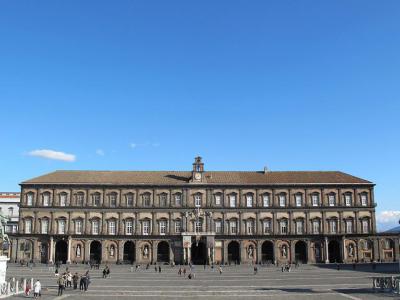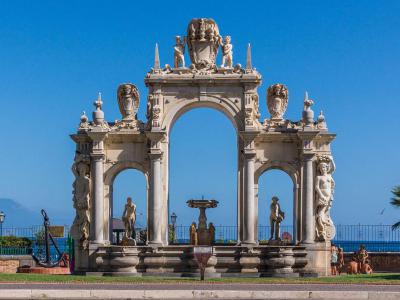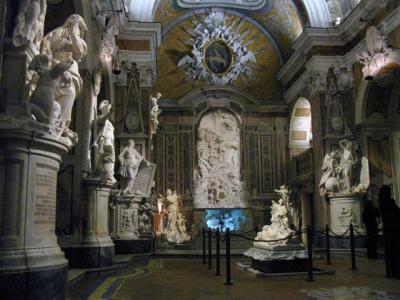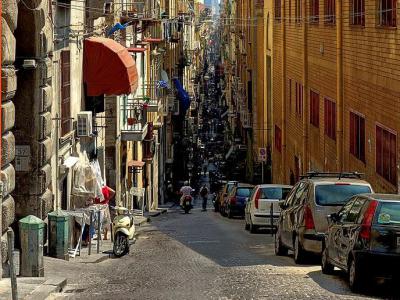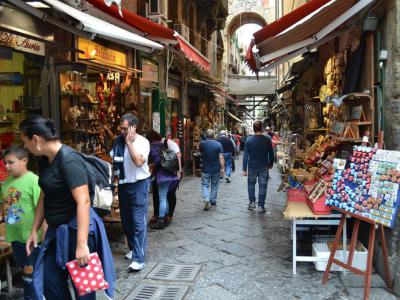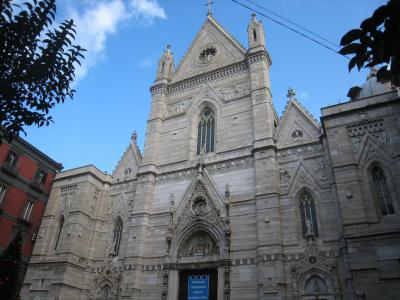Custom Walk in Naples, Italy by pele03084326 created on 2025-02-09
Guide Location: Italy » Naples
Guide Type: Custom Walk
# of Sights: 7
Tour Duration: 2 Hour(s)
Travel Distance: 4.8 Km or 3 Miles
Share Key: 7BQDH
Guide Type: Custom Walk
# of Sights: 7
Tour Duration: 2 Hour(s)
Travel Distance: 4.8 Km or 3 Miles
Share Key: 7BQDH
How It Works
Please retrieve this walk in the GPSmyCity app. Once done, the app will guide you from one tour stop to the next as if you had a personal tour guide. If you created the walk on this website or come to the page via a link, please follow the instructions below to retrieve the walk in the app.
Retrieve This Walk in App
Step 1. Download the app "GPSmyCity: Walks in 1K+ Cities" on Apple App Store or Google Play Store.
Step 2. In the GPSmyCity app, download(or launch) the guide "Naples Map and Walking Tours".
Step 3. Tap the menu button located at upper right corner of the "Walks" screen and select "Retrieve custom walk". Enter the share key: 7BQDH
1) Castel Nuovo (New Castle) (must see)
The New Castle is not new, it is a large medieval castle first built in 1279. Its scenic location and imposing size make the castle one of the main architectural landmarks of the city. It was a royal seat for kings of Naples, Aragon and Spain until 1815.
Commissioned by Charles I of Anjou and built between 1279-82 as the royal residence after the capital of the Sicily Kingdom shifted from Palermo to Naples, it became the venue for all important events during the rule of the Angevin dynasty. The Spanish Aragon dynasty that ruled Naples after the Angevins improved the structure and used it both as a royal residence and a military fortress. The marble entrance arch was created by sculptors from Catalonia in Spain to celebrate the beginning of the Aragonese rule of Naples.
The New Castle has housed the Neapolitan Society of National History since 1875 and the Civic Museum that contains works of art from churches around Naples. It is open for public viewing and managed by the Naples Ministry of Culture. Among the things to see are a display of weapons in the armory hall and the Palatine or Saint Barbara chapel located within the castle. Cultural events and exhibitions are held at the two levels of the southern courtyard and at the Charles V Hall and the Salla della Loggia inside the castle.
The castle is truly breathtaking when observing it from outside. Massive and beautiful, it can really impress. Make sure to visit the excavations underground and also take the elevator/stairs to the top, where the city view is extensive.
Tip:
If you go, it is highly recommended that you join a guided tour, if you want to make most of your visit - the small extra fee is worth it.
Commissioned by Charles I of Anjou and built between 1279-82 as the royal residence after the capital of the Sicily Kingdom shifted from Palermo to Naples, it became the venue for all important events during the rule of the Angevin dynasty. The Spanish Aragon dynasty that ruled Naples after the Angevins improved the structure and used it both as a royal residence and a military fortress. The marble entrance arch was created by sculptors from Catalonia in Spain to celebrate the beginning of the Aragonese rule of Naples.
The New Castle has housed the Neapolitan Society of National History since 1875 and the Civic Museum that contains works of art from churches around Naples. It is open for public viewing and managed by the Naples Ministry of Culture. Among the things to see are a display of weapons in the armory hall and the Palatine or Saint Barbara chapel located within the castle. Cultural events and exhibitions are held at the two levels of the southern courtyard and at the Charles V Hall and the Salla della Loggia inside the castle.
The castle is truly breathtaking when observing it from outside. Massive and beautiful, it can really impress. Make sure to visit the excavations underground and also take the elevator/stairs to the top, where the city view is extensive.
Tip:
If you go, it is highly recommended that you join a guided tour, if you want to make most of your visit - the small extra fee is worth it.
2) Royal Palace (must see)
The Royal Palace is located opposite the Basilica of San Francesco di Paola on the Piazza Plebiscito. It was used as a residence by the Bourbon kings who ruled Naples between 1730 and 1860.
The palace is on the site of an earlier residence, which had housed the former viceroy Don Pedro de Toledo, Marquis of Villafranca. Construction on the present building was begun in the 17th century by the architect Domenico Fontana. It was intended to house the King Philip III of Spain on his visit to this part of his kingdom. However the visit never materialized. Instead the palace initially housed the Viceroy Fernando Ruiz de Castro, count of Lemos.
In 1734, with the arrival of Charles III of Spain to Naples, the palace became the royal residence of the Bourbons. It was greatly expanded and embellished during the reign of King Ferdinand II. The most recent refurbishment was after the damage caused to the structure during World War II.
Today the Royal Palace houses the National Library of Naples, several city offices including the tourist office and a small museum. A magnificent double staircase takes visitors up to the former royal apartments with their lavish furniture and furnishings. The Royal Chapel has a large 18th century Nativity scene that is regarded as the building’s art treasure.
The National Library of Naples has an impressive collection of papyrus scrolls found during excavations at Herculaneum and a 5th century Coptic Bible. The western facade of the palace that faces the Piazza Plebiscito has statues of many of the kings from different dynasties that ruled Naples from the 12th century.
The palace is on the site of an earlier residence, which had housed the former viceroy Don Pedro de Toledo, Marquis of Villafranca. Construction on the present building was begun in the 17th century by the architect Domenico Fontana. It was intended to house the King Philip III of Spain on his visit to this part of his kingdom. However the visit never materialized. Instead the palace initially housed the Viceroy Fernando Ruiz de Castro, count of Lemos.
In 1734, with the arrival of Charles III of Spain to Naples, the palace became the royal residence of the Bourbons. It was greatly expanded and embellished during the reign of King Ferdinand II. The most recent refurbishment was after the damage caused to the structure during World War II.
Today the Royal Palace houses the National Library of Naples, several city offices including the tourist office and a small museum. A magnificent double staircase takes visitors up to the former royal apartments with their lavish furniture and furnishings. The Royal Chapel has a large 18th century Nativity scene that is regarded as the building’s art treasure.
The National Library of Naples has an impressive collection of papyrus scrolls found during excavations at Herculaneum and a 5th century Coptic Bible. The western facade of the palace that faces the Piazza Plebiscito has statues of many of the kings from different dynasties that ruled Naples from the 12th century.
3) Fountain of Giant
The Fountain of the Giant (Fontana del Gigante) is a historical fountain monument in Naples that dates back to the 17th century. Originally, it was constructed next to the Royal Palace of Naples and got its name from its proximity to a massive ancient statue. Over time, it underwent several relocations. First, it was moved to the location of the Palace of the Immacolatella and later, in 1905, it found its current picturesque spot on via Partenope, near the Castel dell'Ovo. Sometimes, it is also referred to as the Fontana dell'Immacolatella.
This fountain, commissioned by Antonio Álvarez de Toledo, the 5th Duke of Alba and Spanish viceroy of Naples, stood near the Royal Palace at the corner of Largo di Palazzo. It featured a colossal statue called "il Gigante" or Giant, seen in historical paintings, including one by Gaspar van Wittel at Palazzo Zevallos Stigliano. The Giant statue, created in 1670, was removed in 1807. The fountain was designed by Florentine artists Pietro Bernini and Michelangelo Naccherino.
The monumental fountain is characterized by its richly decorated Mannerist style. It consists of three rounded arches, each adorned with the heraldic symbols of the Viceroy of Naples and his king. In the central arch, there is a cup held up by two marine creatures, while the statues in the remaining two lateral arches depict river deities holding sea monsters. At the end of the last arches, you'll find two caryatid statues holding cornucopias.
This fountain, commissioned by Antonio Álvarez de Toledo, the 5th Duke of Alba and Spanish viceroy of Naples, stood near the Royal Palace at the corner of Largo di Palazzo. It featured a colossal statue called "il Gigante" or Giant, seen in historical paintings, including one by Gaspar van Wittel at Palazzo Zevallos Stigliano. The Giant statue, created in 1670, was removed in 1807. The fountain was designed by Florentine artists Pietro Bernini and Michelangelo Naccherino.
The monumental fountain is characterized by its richly decorated Mannerist style. It consists of three rounded arches, each adorned with the heraldic symbols of the Viceroy of Naples and his king. In the central arch, there is a cup held up by two marine creatures, while the statues in the remaining two lateral arches depict river deities holding sea monsters. At the end of the last arches, you'll find two caryatid statues holding cornucopias.
4) Museo Cappella Sansevero (Sansevero Chapel Museum) (must see)
The Sansevero Chapel Museum is also known as the Chapel of Santa Maria della Pietà, named for a painting of the Virgin Mary.
The painting has a unique backstory. In the late 16th century, an innocent man was sent to prison. He was released thanks to the miraculous appearance of the Virgin Mary. The innocent man commissioned a painting, The Pietà. Soon, pilgrims flocked to view the painting. One of the pilgrims was John Francesco di Sangro, who was cured of an illness after viewing the painting.
He was so inspired by this miracle that, in 1590, he built a private chapel, which would later be used as a family burial chapel. Raimondo di Sangro, Prince of Sansevero, was responsible for renovating the chapel and commissioning the famous artwork that visitors see today.
The chapel is home to nearly thirty important artworks. Artist Antonio Corradini created The Veiled Truth in 1752 as a monument to Cecilia Gaetani dell'Aquila d'Aragona, Raimondo's mother.
Giuseppe Sanmartino created The Veiled Christ in 1753. This stunning masterpiece was chiseled from marble and shows Christ's suffering body lying under a transparent shroud.
Francesco Queirolo's 1754 The Release from Deception was created as a monument to Raimondo's father. This statue shows a man wrestling a net that entangles him.
Surrounding The Veiled Christ are statues representing different virtues such as modesty, liberality, marital sweetness, education, and self-control.
Francesco Maria Russo painted The Glory of Paradise on the ceiling in 1749. The floor was originally in a black and white labyrinth design.
The chapel also has two unusual displays of preserved skeletons with silk and wax blood vessels and arteries.
Why You Should Visit:
The Sansevero Chapel Museum holds artwork by the most prominent 18th-century Italian artists. The chapel is unassuming on the outside but has a hauntingly beautiful and captivating interior.
Tips:
Make sure you use the audio guide to get the most out of your visit.
The painting has a unique backstory. In the late 16th century, an innocent man was sent to prison. He was released thanks to the miraculous appearance of the Virgin Mary. The innocent man commissioned a painting, The Pietà. Soon, pilgrims flocked to view the painting. One of the pilgrims was John Francesco di Sangro, who was cured of an illness after viewing the painting.
He was so inspired by this miracle that, in 1590, he built a private chapel, which would later be used as a family burial chapel. Raimondo di Sangro, Prince of Sansevero, was responsible for renovating the chapel and commissioning the famous artwork that visitors see today.
The chapel is home to nearly thirty important artworks. Artist Antonio Corradini created The Veiled Truth in 1752 as a monument to Cecilia Gaetani dell'Aquila d'Aragona, Raimondo's mother.
Giuseppe Sanmartino created The Veiled Christ in 1753. This stunning masterpiece was chiseled from marble and shows Christ's suffering body lying under a transparent shroud.
Francesco Queirolo's 1754 The Release from Deception was created as a monument to Raimondo's father. This statue shows a man wrestling a net that entangles him.
Surrounding The Veiled Christ are statues representing different virtues such as modesty, liberality, marital sweetness, education, and self-control.
Francesco Maria Russo painted The Glory of Paradise on the ceiling in 1749. The floor was originally in a black and white labyrinth design.
The chapel also has two unusual displays of preserved skeletons with silk and wax blood vessels and arteries.
Why You Should Visit:
The Sansevero Chapel Museum holds artwork by the most prominent 18th-century Italian artists. The chapel is unassuming on the outside but has a hauntingly beautiful and captivating interior.
Tips:
Make sure you use the audio guide to get the most out of your visit.
5) Spaccanapoli Street (must see)
Spaccanapoli Street can be translated to "Naples splitter." This long street is popular with locals and visitors alike as it provides access to the most popular landmarks and sights in Naples. The ancient street is actually several different streets, such as Via San Biagio and Via Benedetto Croce.
Along Spaccanapoli Street, visitors will find artist's workshops, overhanging balconies, and narrow through-ways. This is the perfect place to immerse yourself in the daily life of Naples.
At the intersection with Via Duomo, visitors will find sweet local stores, bars, restaurants, shopping boutiques, and vegetable stands.
One of the more unique shops is the L'Ospedale delle Bambole, which specializes in restoring statues and antique dolls. Kids enjoy checking out the doll hospital, complete with doll hospital beds. There's also a museum with antique dolls and toys.
While walking, don't miss the opportunity for a distinctive Naples pizza. Stroll along Spaccanapoli to find several important churches and landmarks. Visitors will find the Church of Gesu Nuovo, the Church of Santa Chiara, the Cappella Sansevero, and the Cathedral of San Gennaro.
Along Spaccanapoli Street, visitors will find artist's workshops, overhanging balconies, and narrow through-ways. This is the perfect place to immerse yourself in the daily life of Naples.
At the intersection with Via Duomo, visitors will find sweet local stores, bars, restaurants, shopping boutiques, and vegetable stands.
One of the more unique shops is the L'Ospedale delle Bambole, which specializes in restoring statues and antique dolls. Kids enjoy checking out the doll hospital, complete with doll hospital beds. There's also a museum with antique dolls and toys.
While walking, don't miss the opportunity for a distinctive Naples pizza. Stroll along Spaccanapoli to find several important churches and landmarks. Visitors will find the Church of Gesu Nuovo, the Church of Santa Chiara, the Cappella Sansevero, and the Cathedral of San Gennaro.
6) Via San Gregorio Armeno (St. Gregory of Armenia Street) (must see)
This ancient street was once home to a temple dedicated to Ceres, a Roman Goddess. The faithful would bring small figurines made in nearby shops to the temple. The tradition continues today as this street became famous for artists that create figurines for Nativity scenes.
Nativity scene creations include different size houses, terracotta shepherds, fruit vendors, or even a pizza vendor. In addition, shoppers can find mechanical items to complete the perfect scene, including windmills and waterfalls.
Today, workshops continue to create religious figures and more modern figures such as famous football players, celebrities, and politicians.
This beautiful, narrow alley is the perfect place to shop for a unique souvenir. Visitors might see the artists at work carving out the next figurine. Via San Gregorio Armeno is busy year-round but absolutely packed with locals and tourists during the Christmas season.
Nativity scene creations include different size houses, terracotta shepherds, fruit vendors, or even a pizza vendor. In addition, shoppers can find mechanical items to complete the perfect scene, including windmills and waterfalls.
Today, workshops continue to create religious figures and more modern figures such as famous football players, celebrities, and politicians.
This beautiful, narrow alley is the perfect place to shop for a unique souvenir. Visitors might see the artists at work carving out the next figurine. Via San Gregorio Armeno is busy year-round but absolutely packed with locals and tourists during the Christmas season.
7) Duomo di Napoli (Naples Cathedral) (must see)
Naples Cathedral is also known as The Cathedral of the Assumption of Mary. The church is commonly called Cattedrale di San Gennaro in honor of Saint Januarius.
The construction of the cathedral began in the 13th century and was finally completed in the 14th century. The impressive Gothic cathedral was built on the ruins of previous churches' excavations. Over the years, Greek and Roman artifacts have been found underneath the cathedral.
The neo-Gothic facade wasn't completed until 1905. The interior features a gilded coffered ceiling. Artist Luca Giordano completed the baroque sections of the nave and transept.
Priest and architect Francesco Grimaldi designed the Chapel of the Treasury. Several renowned artists worked on the chapel, which was completed in 1646. Jusepe de Ribera created the stunning Saint Gennaro Escaping the Furnace Unscathed canvas. Giovanni Lanfranco created the magnificent dome fresco. Behind the altar, Saint Januarius's skull and two vials of blood are held in a silver strongbox.
The next chapel contains Saint Januarius's bones in an urn. More of the saint's remains are housed below the altar in the Cappella Carafa chapel.
Visitors will be impressed by the Basilica di Santa Restituta, originally built in the 4th century and renovated in the 17th century. This ancient church holds Europe's oldest baptistry, the Battistero di San Giovanni in Fonte. The baptistry is decorated with 4th-century mosaics.
A vial of blood belonging to revered Saint Januarius is brought out three times a year, and the dried blood usually liquefies. Legend says that when the blood doesn't liquefy, disaster will come to Naples.
Why You Should Visit:
This stunning medieval cathedral holds the miraculous blood of Saint Januarius, priceless artworks, and an early Christian basilica dating to the 4th century. It's a beautiful place to view Italian art and architecture and appreciate Naples' religious culture.
Tips:
The church is closed in the afternoon. Visit between 8:00 am and 12:30 pm, or 4:30 pm and 7:00 pm. The main cathedral is free to enter, but the baptistery charges a small fee.
The construction of the cathedral began in the 13th century and was finally completed in the 14th century. The impressive Gothic cathedral was built on the ruins of previous churches' excavations. Over the years, Greek and Roman artifacts have been found underneath the cathedral.
The neo-Gothic facade wasn't completed until 1905. The interior features a gilded coffered ceiling. Artist Luca Giordano completed the baroque sections of the nave and transept.
Priest and architect Francesco Grimaldi designed the Chapel of the Treasury. Several renowned artists worked on the chapel, which was completed in 1646. Jusepe de Ribera created the stunning Saint Gennaro Escaping the Furnace Unscathed canvas. Giovanni Lanfranco created the magnificent dome fresco. Behind the altar, Saint Januarius's skull and two vials of blood are held in a silver strongbox.
The next chapel contains Saint Januarius's bones in an urn. More of the saint's remains are housed below the altar in the Cappella Carafa chapel.
Visitors will be impressed by the Basilica di Santa Restituta, originally built in the 4th century and renovated in the 17th century. This ancient church holds Europe's oldest baptistry, the Battistero di San Giovanni in Fonte. The baptistry is decorated with 4th-century mosaics.
A vial of blood belonging to revered Saint Januarius is brought out three times a year, and the dried blood usually liquefies. Legend says that when the blood doesn't liquefy, disaster will come to Naples.
Why You Should Visit:
This stunning medieval cathedral holds the miraculous blood of Saint Januarius, priceless artworks, and an early Christian basilica dating to the 4th century. It's a beautiful place to view Italian art and architecture and appreciate Naples' religious culture.
Tips:
The church is closed in the afternoon. Visit between 8:00 am and 12:30 pm, or 4:30 pm and 7:00 pm. The main cathedral is free to enter, but the baptistery charges a small fee.

